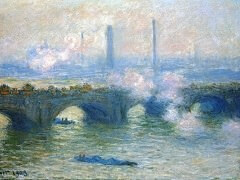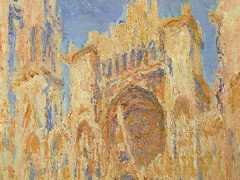The Thames below Westminster, 1871 by Claude Monet

In the fall of 1 870, Monet traveled to London and this painting is one of a series of works he created while based in the British capital. This view is of the Thames and the Houses of Parliament - covered in other pieces - as seen from Victoria Quay. Like many of Monet's other works, it has a photographic quality to it despite its Impressionist style. Again, Monet uses a fragmented brushstroke to create his magical movement in the river. He also, once again, alludes to the fog and smog that gripped London in the later part of the 19th century. The composition is made up of gray tones, with a pink hue that appears on the horizon. It was while in London that Monet met Paul Durand-Ruel who was to become his most supportive patron.
Both Monet and Camille Pissarro - in London to escape the Franco-Prussian War - were intrigued and interested in the city, although the works would prove extremely different in terms of subjects. Pissarro chose the suburbs, while Monet chose the more conventional themes of the Houses of Parliament - as seen here - and Hyde Park.




















